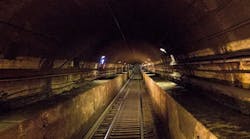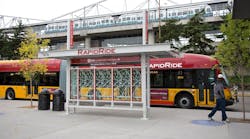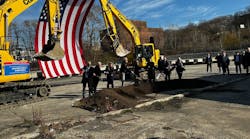Gateway Development Commission secures full funding to build Hudson River Tunnel, rehabilitate existing North River Tunnel
The Gateway Development Commission (GDC) has received $12 billion in federal funding to build the Hudson River Tunnel and rehabilitate the existing North River Tunnel. The $12 billion in funding adds to the $4 billion in funding GDC already had committed for the project, bringing the total amount of funding to $16 billion.
The Federal Transit Administration (FTA) has signed a Full Funding Grant Agreement through the Capital Investment Grants program with the GDC that will allow the FTA to invest close to $6.9 billion to in the project, representing the largest grant ever signed by FTA.
In addition to the $6.9 billion from the FTA, U.S. Department of Transportation (USDOT) Secretary Pete Buttigieg also approved three Railroad Rehabilitation and Improvement Financing loans through USDOT’s Build America Bureau, totaling $4.1 billion, which will provide financial support at below-market interest rates.
Other sources of USDOT support for the project include:
- $3.8 billion through the Federal Railroad Administration’s Fiscal Year 2022-2023 Federal-State Partnership for Intercity Passenger Rail Program for the Northeast Corridor Program.
- $1 billion through Amtrak annual grant funding.
- $25 million through USDOT’s 2023 Rebuilding American Infrastructure with Sustainability and Equity (RAISE) program for the Tonnelle Avenue Bridge Project.
- $292.1 million through USDOT’s 2022 MEGA Grant program for the Hudson Yard Concrete Casing Phase 3 project.
The total $16 billion cost of the project will be split 70/30 between USDOT and the project’s local partners, which include New York, New Jersey and the Port Authority of New York and New Jersey (PANYNJ). The arrangement saves the local partners billions of dollars compared to the original plan to split the project costs 50/50.
“For decades, Americans watched one of the most heavily-used train tunnels in the hemisphere deteriorate and become a bottleneck that affected travelers from New England to the Mid-Atlantic and beyond,” Buttigieg said. “Today, President Biden is making good on his promise to fix that and build the Hudson Tunnel Project. Using funds from the President's Bipartisan Infrastructure Law (BIL), we are building a new tunnel that improves train travel for millions of Americans and revitalizes a rail corridor that is essential to so much of the nation's economy and as one of the cathedrals of American infrastructure, this project can demonstrate America's capacity to build big things together in the 21st century.”
“Today the Biden-Harris Administration and USDOT are delivering on a promise to the riders of New York, New Jersey and along the entire Northeast Corridor to invest $11.7 billion in the Gateway Project, and an additional $4.1 billion in federal loans,” said USDOT Deputy Secretary Polly Trottenberg. “Today represents a major milestone in a years-long effort to build a new Hudson River crossing that has included USDOT, Congress, two states, Amtrak, the Port Authority, local officials, labor partners and more. Together, we are investing in a project that will continue to move Americans forward and contribute to the economic vitality of the nation.”
The Hudson Tunnel Project encompasses a range of components, including a new double-track tunnel between the Bergen Palisades in New Jersey and Manhattan in New York City, rehabilitating the North River Tunnel damaged by Superstorm Sandy in 2012 and creating a concrete casing at Hudson Yards to allow the new tunnel to connect to New York-Penn Station.
“It is important to realize that as we improve New Jersey Transit and Amtrak service in and out of Manhattan, we will improve train and transit service for a region that impacts more than 20 percent of the nation’s economy,” said FTA Acting Administrator Veronica Vanterpool. “FTA is proud to invest in the Hudson Tunnel project so these rails can continue to carry millions of people who keep the American economy humming.”
With the funding secured, GDC can now move forward with heavy construction and tunnel boring activity. Heavy construction will begin in the coming weeks with the Hudson River Ground Stabilization Project, which will stabilize the riverbed on the Manhattan side of the Hudson River to enable the Tunnel Boring Machines (TBM) to excavate the new tunnel.
By the end of 2024, GDC will have awarded contracts for more than $5 billion in construction activity, including contracts to build sections of the tunnel passing through the Palisades in New Jersey and going through the Manhattan bulkhead under the Hudson River Park and will have ordered the first TBM.
“After decades of delays, the Gateway Hudson Tunnel Project is finally moving forward. This Full Funding Grant Agreement will provide the critical resources needed to deliver an essential piece of infrastructure that will bring millions of visitors to New York every year,” said New York Governor Kathy Hochul. “I am proud of the work we have done with President Biden, Secretary Buttigieg, Amtrak and our partners in New Jersey to advance this project.”
“Today marks a significant milestone on the path to ensuring the success of our nation’s most vital infrastructure project,” said New Jersey Governor Phil Murphy. “Thanks to the leadership of our partners, both in Congress and across the Hudson, our federal government will be covering over 70 percent of the total cost of the Gateway Tunnel Project. As the main artery of our nation’s economy continues to be pushed to its limits, we are now one step closer to transforming the 100-year-old infrastructure under the Hudson River. New Jersey thanks the Biden-Harris Administration for delivering this critical investment so that our region’s transportation system will be able to support a new century of American leadership.”
When the new tunnel and the rehabilitated tunnel open, which is estimated to happen by 2038, the project will provide four modern rail tunnels for Amtrak and New Jersey Transit trains. In addition, the project will provide the capability to significantly expand capacity in the future.
“The Hudson Tunnel Project is a key portion of the transportation network along the Northeast Corridor that supports not only the region’s, but the nation’s economy,” said PANYNJ Executive Director Rick Cotton. “The Port Authority is pleased to have provided an important element of the local funding share that has resulted in the full funding of the project achieved today.”
USDOT says additional project benefits include building resiliency and safeguarding rail operations against future extreme weather events, managing floods on both sides of the Hudson River and creating a safer environment for first responders, maintenance workers and the public, especially in the event of an evacuation.
American Public Transportation Association President and CEO Paul P. Skoutelas praised the funding efforts by USDOT for the project.
““Today marks a historic day in American infrastructure with the Federal Transit Administration signing a Full Funding Grant Agreement that authorizes the agency to invest nearly $6.9 billion – the largest grant in FTA history – in the Hudson River Project,” Skoutelas said in a statement. “This landmark project underscores the Administration’s commitment to revitalizing and modernizing American infrastructure under the Bipartisan Infrastructure Law. It will enhance passenger rail travel for millions, support economic vitality and demonstrate the nation’s capacity for large-scale, collaborative achievements. Historic investments under the BIL are vital for America’s future strength and prosperity. Strong public transit and passenger rail grows the economy by connecting people to jobs, education, healthcare, businesses and opportunities. Investing fully in public transportation will benefit all Americans.”

Brandon Lewis | Associate Editor
Brandon Lewis is a recent graduate of Kent State University with a bachelor’s degree in journalism. Lewis is a former freelance editorial assistant at Vehicle Service Pros.com in Endeavor Business Media’s Vehicle Repair Group. Lewis brings his knowledge of web managing, copyediting and SEO practices to Mass Transit Magazine as an associate editor.





